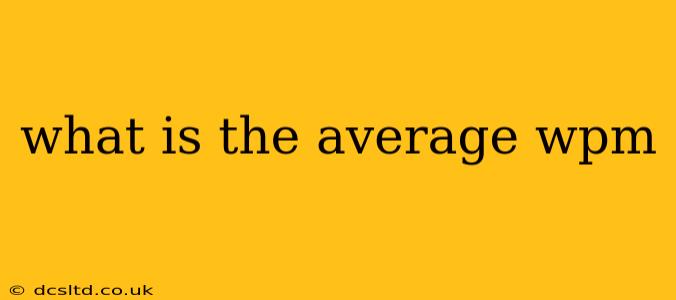What is the Average WPM?
The average words per minute (WPM) typing speed varies significantly depending on several factors, making it difficult to give a single definitive answer. However, we can explore different averages and the factors that influence them.
Understanding the Variables:
Several elements impact typing speed, including:
- Age and Experience: Beginners typically type much slower than experienced typists. Children will have lower WPM than adults, and adults who have been typing for years will generally outperform those with less experience.
- Typing Method: Touch typing (typing without looking at the keyboard) is significantly faster than hunt-and-peck typing.
- Familiarity with the Text: Typing familiar words and phrases is quicker than typing unfamiliar text.
- Accuracy vs. Speed: Prioritizing speed often leads to more errors. A balance between speed and accuracy is ideal.
- Type of Test: Different typing tests use different methodologies and texts, leading to variations in results.
Average WPM by Group:
- Beginners: Beginners might type between 10 and 20 WPM.
- Average Adult: A reasonable estimate for the average adult who types regularly (but isn't a professional typist) is around 40-60 WPM.
- Experienced Typists: Experienced typists, such as professional writers or data entry clerks, can achieve speeds of 60 WPM or higher, often exceeding 80 or even 100 WPM. Some highly skilled typists can reach incredible speeds exceeding 120 WPM.
How is WPM Calculated?
WPM is calculated by dividing the number of words typed by the number of minutes taken. Most online typing tests automatically calculate your WPM, considering both typed words and errors.
What's a Good WPM?
What constitutes a "good" WPM depends entirely on your context and goals. For personal use like emailing or social media, a speed of 40-60 WPM is often sufficient. For professional roles requiring significant typing, higher speeds are beneficial and often expected.
How Can I Improve My WPM?
Many resources are available online to help you improve your typing speed and accuracy. These typically involve:
- Online typing tutors: These programs provide structured lessons and practice exercises to improve technique and speed.
- Practice: Consistent practice is key. Try typing regularly, even if it’s just for a few minutes each day.
- Touch typing tutorials: Learning touch typing is a crucial step towards faster typing speeds.
- Focus on Accuracy: Prioritizing accuracy over speed initially will lead to faster and more efficient typing in the long run.
Are there different standards for WPM in different languages?
Yes, the average WPM can vary slightly depending on the language. Languages with longer average word lengths might result in slightly lower WPM scores for the same typing speed, compared to languages with shorter average word lengths. The difference isn't usually dramatic, though.
What about the impact of keyboard type on WPM?
Different keyboards can subtly impact typing speed. Ergonomic keyboards, for example, might take some adjustment initially, but could improve speed and reduce strain over time. However, the type of keyboard is far less influential on WPM than typing technique and practice.
Ultimately, the "average WPM" is a broad range, and individual speeds vary greatly. Focus on consistent practice and proper technique to improve your own typing speed.
